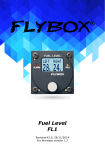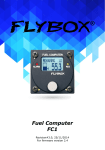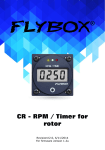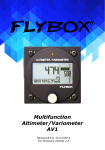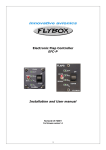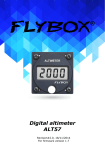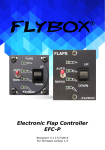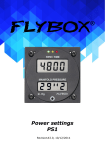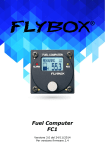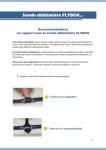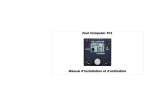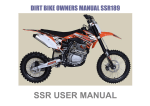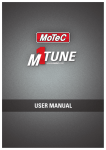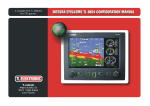Download Propeller regulator PR1-P ® - Flybox Innovative Avionics
Transcript
Flybox ® Flybox ® Propeller regulator PR1-P Revision#3.0, 14/11/2014 PR1-P - User’sversion manual For firmware 3.5 Rev. 3.0 Page intentionally left blank SECTIONS MECHANICAL INSTALLATION ELECTRICAL INSTALLATION OPERATING INSTRUCTIONS INSTRUMENT SETTINGS USE WITH EXTERNAL COMMANDS TECHNICAL SPECIFICATIONS Flybox® Introduction Thank you for purchasing a Flybox® product. We hope it fully satisfy you and makes your flights pleasant and secure. Developing PR1-P, our intent was to create a compact and lightweight propeller controller, easy to install and use. SYMBOLS USED IN THE MANUAL NOTE: Used to highlight important informations. CAUTION: Used to warn the user and indicate a potentially hazardous situation or improper use of the product. WARNING: Used to indicate a dangerous situation that can cause personal injury or death if the instruction is disregarded. PR1-P - User’s manual Rev. 3.0 Flybox ® Important notices & warnings NOTE: Keep this manual in the aircraft. This document must accompany the instrument in the event of change of ownership. NOTE: This device is intended for installation onto non type certified aircraft only, because it has no aviation certifications. Refer to your local aviation authorities to check if this device may be installed in your aircraft. CAUTION: Read entirely this manual before installing the instrument in your aircraft, and follow the installation and operating instructions described here. CAUTION: The pilot must understand the operation of this instrument prior to flight, and must not allow anyone to use it without knowing the operation. Don't use this instrument in flight until you are sure of the correct operating of the same. CAUTION: When the installation is finished you must do a test, prior to flight, switching on all the possible source of electric noise and checking the properly operation of this instrument. CAUTION: The software of this instrument can be subject to change, update, addition or removal of functions, so also the operating mode of the instrument can be subject to change. Always refer to the installation and operating manual updated with the software version used in your instrument. To obtain updated manuals, please visit www.flyboxavionics.it. PR1-P - User’s manual Rev. 3.0 Important notices & warnings Flybox® CAUTION: Using this instrument over the maximum allowable ranges can cause malfunction or wrong indications. CAUTION: the EFC-P must be turned off in case of start with booster. open the corresponding breaker before starting. warranty shall not apply for damage to the EFC-P for this reason. WARNING: The PR1-P is directly connected to the propeller pitch actuator: the non-respect of the notices above or a damage to the PR1-P may result in unexpected pitch changes. WARNING: Responsibility for installation lies entirely with the installer. Responsibility for operations lies entirely with the operator. Responsibility for any calibration, settings or any other customization lies with the person performing these operations. IMPORTANT: If you do not agree with the notices above do not install this instrument in your aircraft, but return the product for a refund. Microel s.r.l. reserves the right to change or improve its products. Information in this document is subject to changes without notice. PR1-P - User’s manual Rev. 3.0 Flybox ® Index INDEX SECTION 1 - Mechanical installation 1.1 - Mechanical installation …….…………………………….. 8 SECTION 2 - Electrical installation 2.1 - Electrical installation …….………..………………….….. 10 2.2 - Panel indicators and commands ..…………………….….. 13 2.3 - Wiring check ……….….……………….…………….…... 14 SECTION 3 - Operating instructions 3.1 - Use of the instrument …….….…..………….……………. 3.2 - Use in “Constant speed” mode .………….….……………. In case of failure or emergency ……….…….………..…. 3.3 - Use in “Manual” mode .………….………….……………. 16 17 19 20 SECTION 4 - Instrument settings 4.1 - Functions menu .…..….….……….……..….……………. 21 4.2 - Setup menu .…….……………….………….……………. 23 4.3 - Additional functions …….……….………….……………. 24 SECTION 5 - Use with external commands 5.1 - Using an external potentiometer or the Flybox® lever mod. PR1PL .……………………………. 27 5.2 - Using an external switch …………………….……………. 29 SECTION 6 - Technical specifications ……..…….……………. 30 Warranty …….…………………………………….……………. 31 PR1-P - User’s manual Rev. 3.0 Flybox® Mechanical installation SECTION 1 1.1 MECHANICAL INSTALLATION The PR1-P fits in a standard 2 1/4” panel cutout; it's recommended to choose a position that permits optimal display visibility. It's furnished with four M4 screws to install it to the panel, if you use other screws consider that the maximum thread length is 15mm (see following picture). 8 PR1-P - User’s manual Rev. 3.0 Flybox ® Mechanical installation All dimensions are in millimeters PR1-P - User’s manual Rev. 3.0 9 Flybox® Electrical installation SECTION 2 2.1 ELECTRICAL INSTALLATION On the back of the FC1 there is a 15-pole male connector; it is also furnished with the corresponding 15-pole female connector, to be wired as follows: 15-pole female connector, view from wiring side 10 PR1-P - User’s manual Rev. 3.0 Flybox ® Electrical installation Connector pinout: 1= +12V Main supply 2= GND Main supply 3= Motor out (+) 4= POT + (positive) for external lever/potentiometer (optional) 5= “INC EXT” signal for external INC/DEC switch (optional) 6= “DEC EXT” signal for external INC/DEC switch (optional) 7= not used/reserved 8= GND for external INC/DEC switch (optional) 9= not used/reserved 10= POT - (negative) for external lever/potentiometer (optional) 11= Motor out (-) 12= POT C (cursor) for external lever/potentiometer (optional) 13= not used/reserved 14= not used/reserved 15= RPM input signal (minimum signal voltage: 10V) PR1-P - User’s manual Rev. 3.0 11 Flybox® Electrical installation NOTE: Insert an adequate circuit breaker to the power lead, depending on the current consumption of the propeller motor (MAX 7.5 A). Use avionic cable. Use shielded cable to connect an external lever or potentiometer. Take care to properly insulate any exposed wire, to avoid short circuit between any of the wires. CAUTION: Voltage peaks that exceeds the operating limits on the supply line (20V) can damage the device. CAUTION: The PR1-P must be turned off in case of start with booster. Open the corresponding breaker before starting. 12 PR1-P - User’s manual Rev. 3.0 Flybox ® Indicators & commands 2.2 PANEL INDICATORS AND COMMANDS Max pitch LED Min pitch LED Operating mode switch INC/DEC switch Knob with pushbutton The knob with pushbutton can be rotated (for example to increment or decrement the RPM) or pressed like a pushbutton (for example to enter in the menu or in the various settings). NOTE: The operating mode switch has a safety lock to avoid accidental operation: it must first pulled on the outside and then moved to the desired position. PR1-P - User’s manual Rev. 3.0 13 Flybox® Wiring check 2.3 WIRING CHECK Before using the PR1-P in flight for the first time you must execute this checklist (with the engine turned off): ● Turn-on the PR1-P. ● Put the operating mode switch in the “Manual” position. ● Press the “INC/DEC” switch in the “INC” position (increment RPM) and check that the propeller pitch decrease; check also that the “Min pitch” LED will go on when the propeller reach the min pitch stop. If the propeller pitch change in the wrong direction (towards the max pitch) you must invert the two motor out cable (Motor+ and Motor-). ● Press the “INC/DEC” switch in the “DEC” position (decrement RPM) and check that the propeller pitch increase; check also that the “Max pitch” LED will go on when the propeller reach the max pitch stop. ● Turn-on the engine and execute a propeller/regulator test (see the function “Prop test” in chap.4.1). NOTE: Perform this wiring check after every modifications or maintenance of the propeller system to verify that all connections are restored correctly. 14 PR1-P - User’s manual Rev. 3.0 Flybox ® Wiring check NOTE: Refer to the propeller constructor's manual if you need to adjust the mechanical min and max pitch stop of the propeller. NOTE: PR1-P works only with this type of propellers: PR1-P - User’s manual Rev. 3.0 15 Flybox® Use of the instrument SECTION 3 3.1 USE OF THE INSTRUMENT The PR1-P has two operating modes: “Constant speed” and “Manual”: you can select the operating mode using the corresponding switch on the frontpanel. For normal operations use always the “Constant speed” mode; the “Manual” mode must be used in case of emergency or failure of the PR1-P because it exclude the electronic system and drive directly the pitch motor using the INC/DEC switch. At startup the display briefly shows the software version, then it appear the main screen (see next chapter) or the “MANUAL” indication if the operating mode switch is in the “Manual” position. 16 PR1-P - User’s manual Rev. 3.0 Flybox ® Use in “CONSTANT SPEED” 3.2 USE IN “CONSTANT SPEED” MODE ACTUAL RPM: Shows the actual RPM (measured RPM) of the engine. INTENDED TARGET RPM: Shows the desired RPM that the engine must keep. At startup, the target RPM are set to 5700 (with factory settings, except if you are using an external potentiometer). To change the target RPM you can use either the knob or the INC/DEC switch (INC to increment the RPM and DEC to decrement the RPM). In both case the increment/decrement can be in step of 10,25,50 or 100 RPM, depending on the setting “RPM step” in the setup menu (see item “RPM step” in the “Setup menu”). PR1-P - User’s manual Rev. 3.0 17 Use in “CONSTANT SPEED” Flybox® The PR1-P, when properly installed and configured, can always be used in “Constant speed” mode, by the starting, take-off, landing, making sure to always perform the following checks: ● Before the take-off: - Perform a propeller test as explained in chap. 4.1, “Prop test” function. - Check that the min pitch green led is turned on. - Check that the target RPM are set to the takeoff value. ● During the take-off: - Check that the engine takes the required RPM. ● During the climb: - Engine RPM and speed checks. ● During the flight: - Set the desired RPM by turning the knob or using the INC/DEC switch. ● Before landing: - Set the target RPM to the takeoff value. If you have any doubt about using a constant-speed variable pitch propeller, contact a qualified instructor. 18 PR1-P - User’s manual Rev. 3.0 Flybox ® Use in “CONSTANT SPEED” IN CASE OF FAILURE OR EMERGENCY: If during any phase of flight you notice that the PR1-P don't adjust correctly the propeller pitch turn immediately the operating mode switch to the “Manual” position; this switch has a safety lock to avoid accidental operation: it must first pulled on the outside and then moved to the desired position. PR1-P - User’s manual Rev. 3.0 19 Flybox® Use in “MANUAL” 3.3 USE IN “MANUAL” MODE The “Manual” mode must be used only when testing the propeller system and in case of failure or emergency. In this mode the propeller pitch is adjusted using exclusively the INC/DEC switch: press in the “INC” position to increment the engine RPM and press in the “DEC” position to decrease it. The display shows only a screen with a fixed “Manual” indication. NOTE: - To adjust the propeller pitch in “MANUAL” mode you must use exclusively the INC/DEC switch on the PR1-P frontpanel, because the knob and the external switch/lever (if presents) has no effect. - If you take-off in “MANUAL” mode, it's your task to rev the engine with the throttle lever and pay attention to not overspeed the engine. 20 PR1-P - User’s manual Rev. 3.0 Flybox ® Functions menu SECTION 4 4.1 FUNCTIONS MENU To display the functions menu press the knob for at least one second. Done: return to the main screen. Prop test: execute a self-test (varying the propeller pitch) to check the correct working of the system regulator/propeller. To execute this test you must rev up the engine to an appropriate value (for example 5000RPM for ROTAX 912/914) and press the knob to start the propeller test. The PR1-P will increase the pitch until the p r o p e l l e r reach the RPM value that you should have already set (see “RPM prop t.” in the setup menu, for example 4000 RPM for ROTAX 912/914) Once reached this minimum value (4000 RPM in this example) it returns to the initial RPM (in this example 5000 RPM). While the PR1-P is in this test, you can press the knob or the INC/DEC switch to stop the test and bring the propeller to the min pitch position. PR1-P - User’s manual Rev. 3.0 21 Flybox® Functions menu NOTE: To prevent accidental activation of the test when in flight this function is removed after the takeoff (the PR1-P consider a takeoff when the engine meets or exceeds 4000 RPM for 30 seconds). So if you perform an engine test above 4000 RPM and longer than 30 secs you can’t run the “Prop test” automatically but you have to manually test the propeller , by varying the pitch with the knob or with the INC/DEC switch. Light: Turns on/off the display backlight. Setup: enter the setup menu (see next chapter). 22 PR1-P - User’s manual Rev. 3.0 Flybox ® Setup menu 4.2 SETUP MENU Done: Exit the setup menu and return to the main screen. Contrast: adjust the LCD contrast. Display: set the display mode (white or black background). RPM prop t.: set the RPM that the engine must reach in the propeller test. RPM step: set the minimum step when changing the RPM with the knob or the INC/DEC switch. The step value can be 10,25,50 or 100 RPM. PR1-P - User’s manual Rev. 3.0 23 Flybox® Additional functions 4.3 ADDITIONAL FUNCTIONS To enter in the additional functions menu you must go in the setup menu, then position the cursor in the first line (“Done”) and keep pressed the knob for 3 seconds, until the display shows a screen that allows you to insert a password: now insert the password “2010” and the display will show this menu: Done: exit and return to the main screen. Hour: Shows the effective operating time of the propeller pitch electric motor (indications in hhhh:mm). If you keep pressed the knob for 10 seconds the number become editable and you can rotate the knob to modify the value of the hour, then press again the knob to modify the minutes; at this point you can adjust the minutes and press the knob to store the new value or you can keep pressed the knob for 10 seconds to reset to zero the counter. Resetting the hour-meter is useful, for example, when installing a new electric motor for the propeller pitch, or when installing the PR1P in another aircraft. 24 PR1-P - User’s manual Rev. 3.0 Flybox ® Additional functions The following parameters are already set in factory and it's recommended to modify it only if the PR1-P don't work correctly during the propeller pitch regulation. CAUTION: the parameters must be modified only by qualified persons and must not be modified during the flight. KP DEC: adjust the pitch speed variation when the PR1-P is decreasing the RPM (increase the pitch). Increasing this value means increasing the response speed of the system but if the value is too high the response become inaccurate, unstable and the regulation may oscillate. Modify this value in step of 100 units and then check the effect in flight (range = 100~5000). KI DEC: this parameter affect the response regulation when the system try to decrease the RPM without manage to reach the setpoint. If this value is too high the regulation may oscillate. Modify this value in step of 5 units and then check the effect in flight (range = 0~100). KP INC: adjust the pitch speed variation when the PR1-P is increasing the RPM (decrease the pitch). Increasing this value means increasing the response speed of the system but if the value is too high the response become inaccurate, unstable and the regulation may oscillate. Modify this value in step of 100 units and then check the effect in flight (range = 100~5000). PR1-P - User’s manual Rev. 3.0 25 Flybox® Additional functions KI INC: this parameter affect the response regulation when the system try to increase the RPM without manage to reach the setpoint. If this value is too high the regulation may oscillate. Modify this value in step of 5 units and then check the effect in flight (range = 0~100). Dead band: To prevent continuous actions of the propeller pitch electric motor it's possible to use this parameter: if the difference between the measured RPM and the intended RPM is lower than this parameter there will be no pitch regulation. (Default value=20, range=0~100). RPM in filter: Default value=5, range=1~100. Don’t modify this parameter, consult the constructor. 26 PR1-P - User’s manual Rev. 3.0 Flybox ® Using an external pot. SECTION 5 5.1 USING AN EXTERNAL POTENTIOMETER OR THE Flybox® LEVER MOD. PR1PL It's possible to connect the PR1-P to an external potentiometer (with resistance from 5 to 10 kohm) or to the Flybox® lever mod. PR1PL, that allow an even more intuitive regulation of the propeller; to connect the PR1-P to a lever/potentiometer follow the wiring connection (ch. 2.1) and then execute this procedure to enable and calibrate it: - Enter the setup menu, then position the cursor in the first line (“Done”) and keep pressed the knob for 3 seconds, until the display shows a screen that allows you to insert a password; now insert the password “1024” and the display will show this menu: Done: exit and return to the setup menu. Pot enable: enable or disable the external lever/potentiometer. Press the knob to enable (ON) or disable (OFF). PR1-P - User’s manual Rev. 3.0 27 Flybox® Using an external pot. Pot min: Position your lever/potentiometer to the minimum value (min. RPM value) and press the knob to allow the PR1-P store this position. RPM min: Insert here the RPM indicated in your lever/potentiometer at the min RPM position (the same position stored in the previous step). Pot max: Position your lever/potentiometer to the maximum value (max. RPM value) and press the knob to allow the PR1-P store this position. RPM max: Insert here the RPM indicated in your lever/potentiometer at the max RPM position (the same position stored in the previous step). Now your lever/potentiometer is correctly calibrated and you can exit from the menu (click on “Done”). NOTE: - In “Constant Speed” mode: enabling the external lever/potentiometer will disable the knob and the INC/DEC switch on the frontpanel, so the RPM adjustment is done exclusively by the lever/potentiometer. - In “Manual” mode: the external lever/potentiometer will be disabled and you must use exclusively the INC/DEC switch on the frontpanel of the PR1-P. 28 PR1-P - User’s manual Rev. 3.0 Flybox ® Using an external switch 5.2 USING AN EXTERNAL SWITCH It's possible to connect an external switch to adjust the RPM in the same way as the INC/DEC switch on the frontpanel: to connect the PR1-P to an external switch follow the wiring connection (ch. 2.1); the switch must have this characteristics: single pole, double throw with momentary up/down position. NOTE: - In “Manual” mode the external switch is disabled and you must use exclusively the INC/DEC switch on the frontpanel of the PR1-P. - If you already use an external lever/potentiometer (see previous chapter) it's not possible to use also an external switch. PR1-P - User’s manual Rev. 3.0 29 Technical specifications Flybox® SECTION 6 6.1 TECHNICAL SPECIFICATIONS ● Graphic LCD with backlight and coated glass, dimensions 29x18mm. ● Standard mounting 2 1/4” (57mm). ● Anodized aluminium case. ● Dimensions: 60.0 x 60.0 x 52.6 mm. ● Weight: 190 g. ● Operational temperature range: -10 ~ +70°C. ● Supply voltage: 11 ~ 20 V=. ● Supply current: 100mA. ● Maximum motor supply current: 7 A . ● Minimum RPM voltage signal: 10 V. ● Measurable RPM range: 1000 to 8000 RPM. ● RPM Resolution: 10 RPM. ● RPM Accuracy: 0.02%. 30 PR1-P - User’s manual Rev. 3.0 Flybox ® WARRANTY: This product is warranted to be free from defects for a period of 12 months from the user invoice date. The warranty only cover the manufacture's defects; shall not apply to product that has been improper installed, misused or incorrect maintenance, repaired or altered by non-qualified person. Date 09/2010 09/2011 10/2012 09/2013 11/2014 Revision 26 27 28 29 30 Description Updated installation notes Updated wiring installation General revision Updated wiring installation Layout update WARNING: All photos, data, drawings, instruments layouts, technical solutions and data representation you find in this document or watching at Flybox® instruments working and/or you can access by means of any other media, including web sites, are sole property of MICROEL s.r.l., cannot be copied or imitate without a written permission of MICROEL s.r.l. itself and are protected by law, even by means of extended international copyright and/or specific patents deposited. Any infringement of this statement and of MICROEL s.r.l. intellectual property will be prosecuted. ©2014 Microel s.r.l. – all rights reserved. PR1-P - User’s manual Rev. 3.0 31 MICROEL s.r.l. Via Mortara 192-194 27038 Robbio (PV) - ITALY Tel +39-0384-670602 - Fax +39-0384-671830 www.flyboxavionics.it
































